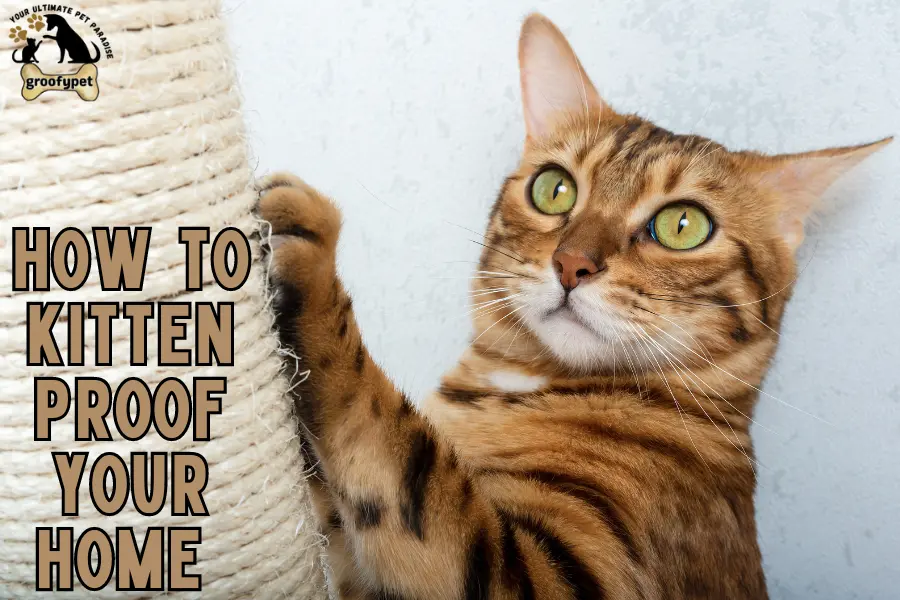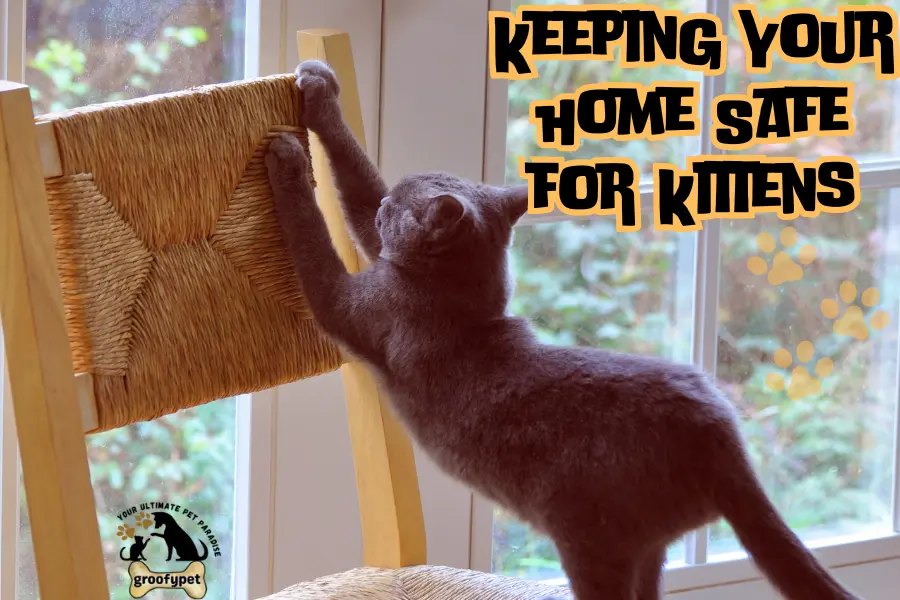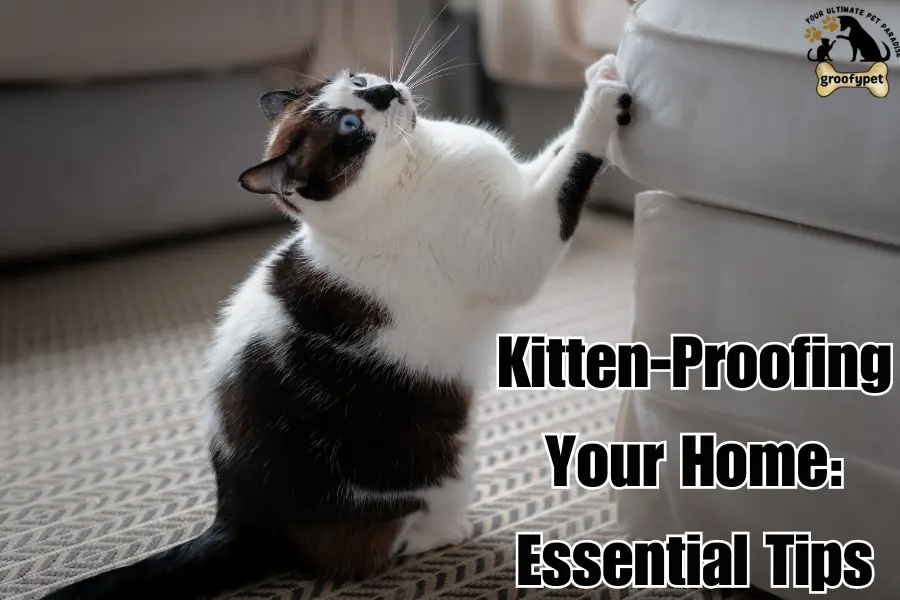
When I welcomed my spunky little kitty into the family, the excitement of her gotcha day quickly turned into the realization that proofing my home was imperative. The question is How To Kitten Proof Your Home? Kittens, with their natural mischief, have a way of getting into dangerous situations that we never expect.
I made sure to focus on hidden hazards that my furry friend might expose herself to, especially when she would climb or take a leap onto furniture. Childproof latches on cabinets and securing harmful items in the garage or backyard became necessary to protect her curious nature. I learned it’s all about creating an adequate environment while allowing for her young and playful spirit to thrive.
Kitten-proofing also means being mindful of what they can access. Whether it’s fragile items or toxic plants, you’ll want to create a safe environment while allowing them space to grow. Protecting your kitten doesn’t only safeguard your furniture but also encourages positive cat behavior, reducing the risk of them developing bad habits. With a bit of patience and the right tools, you can keep your home kitten-friendly while still enjoying the playfulness that comes with raising such a curious companion.
Additionally, I found it helpful to use this handy guide as I adapted the resident cat’s routine to the new kitten. Acclimating her was crucial, and I quickly realized that taking proper precautions is key to avoid any regret later on. A thorough makeover of the pet’s space was needed, including protecting furniture and using deterrents for chew-prone areas.
Kittens love to scratch and eat things they shouldn’t, so securing areas with childproof latches and keeping an eye on the garden were essential. Even though it involved a lot of work, the annual celebration of her birthday always reminds me that a little extra caution goes a long way in ensuring a safe and joy-filled home for our mischievous new member.
Table of Contents
ToggleHow to Kitten Proof your Home-The Best Answer
Kitten proofing is essential to keep your adorable ball of fluff safe and prevent them from damaging your belongings. It ensures your kitten stays out of harm’s way while promoting healthy feline behavior like using a scratching post instead of your furniture.
Keeping Your Home Safe for Kittens
To ensure how to kitten proof your home your home is safe for your new kitten, start by viewing it from your kitten’s perspective. Kittens are curious and love to climb, leap, and crawl into unexpected places. As you explore each room, be aware of potential hazards. Cables and wires should be secured with protective tubing or taped down to prevent chewing. Items that dangle, like curtain tassels or blind cords, should also be kept out of reach.

Make sure to close off any potential escape routes. Lock all windows, doors, and cupboards, and cover any gaps in floorboards or behind kitchen units. This helps keep your kitten safe from dangers such as road traffic or other animals. Creating a safe space requires a bit of creativity and attention to detail, but keeping these tips in mind will help you create a secure environment for your playful companion.
1.Managing Cables and Dangling Items
When it comes to managing cables, wires, and items that dangle, it’s crucial to think like a kitten. Kittens use their paws and mouths to explore, so anything within reach can be a potential hazard. How To Kitten Proof Your Home? To keep these items safe, make sure they are taped down or encased in plastic tubing. This helps to prevent them from being chewed on or pulled.
For curtain tassels, window blinds, and any other cords that might dangle, ensure they are tidied away or securely fastened. These can easily become toys for a curious kitten, so it’s best to keep them out of reach to avoid accidents. Regularly check these areas to ensure they remain safe and kitten-proofed.
2.Securing Escape Routes
To kitten proof your home, it’s important to close off any potential escape routes. Kittens are naturally curious and love to explore, so make sure to lock all windows, doors, and cupboards. Secure balconies and garages by keeping them shut at all times. Don’t overlook gaps in floorboards or behind kitchen units; these can also be potential hazards.
By carefully planning and blocking these routes, you prevent your kitten from wandering outside where they could face dangers like road traffic, foxes, and other pets. How to kitten proof your home? Ensuring your home is tightly secured will keep your kitten safe and happy as they explore their new environment.
3.Storing Small and Harmful Items Safely
To keep your kitten safe, it’s essential to lock away any harmful items. These include things like rubber bands, string, and ribbon, which can be tempting for your curious kitten. Without proper supervision, kittens might chew on or swallow these objects, leading to potential health issues.
Make sure these items are kept out of reach by storing them in secure places. Monitor your kitten’s behavior around these items to ensure they don’t get access to them. By taking these precautions, you can prevent accidents and keep your playful kitten safe from harm.
4.Keeping Harmful Substances Out of Reach
How to kitten proof your home? To kitten proof your home, it’s crucial to lock away any harmful substances. This includes cleaning products and medicines, which should be stored safely where your kitten can’t get to them. Use a secure cabinet that is firmly closed to keep these items out of your kitten’s paw’s reach.
Always check that these items are not within easy reach. Ensuring that harmful substances are safely locked away will help protect your curious kitten from potential accidents and keep your home safe.
5.Unsafe Human Foods for Kittens
When kitten proofing your home, it’s vital to be aware of human foods that can be dangerous for your little friend. Common foods like chocolate, onions, and chewing gum can cause serious health issues if ingested by kittens. Keep these foods securely out of reach to prevent any accidental consumption.
Always be cautious about what you leave around your kitten. Even small amounts of these harmful items can be risky, so it’s best to store them in places your kitten cannot access. By being vigilant, you can keep your kitten safe from potential dangers.
6.Safe Houseplants and Flowers for Kittens
When kitten proofing your home, be cautious about the plants and flowers you keep around. Some plants can be toxic to kittens. For example, amaryllis, azalea, lily, and lily of the valley are known to be harmful if a kitten decides to nibble on them.
To keep your kitten safe, either choose plants that are safe or ensure that any potentially dangerous plants are placed in a room your kitten cannot access. This way, you can enjoy beautiful greenery without risking your kitten’s health.
7.Keeping the Toilet Lid Closed
One essential step in kitten proofing your home is to always keep the toilet lid down. Kittens are curious and might try to explore every nook and cranny, including the toilet. If the lid is left up, a kitten could fall in, leading to a tragic situation.
Make sure all the humans in the household are aware of this rule and consistently follow it. This simple precaution helps keep your kitten safe from accidents and ensures they don’t get into potentially harmful situations.
8.Keeping Laundry Doors Closed
When kitten proofing your home, it’s important to keep the washing machine and tumble drier doors closed. Kittens love finding dark and cozy places to sleep, and these appliances can seem like the perfect hideaway.
Before you start switching on the machines, always check the drum to ensure no kitten has snuck inside. By keeping these doors shut, you prevent your kitten from getting trapped or injured, making your home a safer place for them.
9.Safety Measures for Fires and Heat Sources
When kitten proofing your home, be extra cautious around fires and heat sources. Kittens are naturally drawn to warmth, so it’s essential to install a fireguard around any open fires. This prevents your furry friend from getting too close and potentially getting hurt.
Also, avoid leaving candles unattended, as they can be a serious hazard. Ensuring these precautions are in place helps keep your kitten safe and prevents accidents related to heat sources.
10.Safe Waste Management for Kittens
To kitten proof your home, it’s crucial to use covered wastepaper bins. Kittens are naturally curious and might explore uncovered bins, leading to accidents or eating harmful contents. Keeping bins covered prevents them from getting into trouble and keeps your space clean.
Avoid using uncovered bins, as they invite your kitten to investigate and potentially make a mess. By choosing bins with secure lids, you reduce the risk of accidents and keep your home safer for your playful kitten.
How To Kitten Proof Your Home : Essential Tips
Kittens, with their boundless curiosity and agility, can easily find themselves in precarious situations or cause mischief with your delicate items.

To prevent any accidents or damage, consider the following steps for kitten-proofing your home:
1.Assess Your Home
Start by evaluating high shelves, low cupboards, and hidden corners. Ensure that fragile or valuable items are out of reach and that your kitten can’t get trapped in cupboards.
2.Secure Craft Supplies
If you enjoy needlework, store needles and yarn in a closed container. These items can be hazardous if ingested by a curious kitten.
3.Tidy Window Blinds
Fold and secure blind cords with a rubber band to prevent your kitten from becoming entangled and potentially strangled.
4.Invest in Covered Trashcans
Kittens love to explore and will often knock over trashcans. Use covered bins to keep garbage off the floor and out of reach.
5.Close Dryer Doors
Always keep the door to your dryer closed and check inside before using it. Cats may seek out warm, dark places to sleep, which can be dangerous.
6.Keep Floors Clean
Remove stray rubber bands, ribbons, and twine from the floor. These can be hazardous if ingested by a kitten.
7.Cover Food
Ensure that any food left out is covered. Kittens are drawn to food smells, and some human foods, like chocolate, are toxic to them.
8.Secure Drapes
Keep cloth drapes out of your kitten’s reach by tying them up until your kitten learns to use a scratching post.
9.Keep Toilets Covered
Always keep toilet lids closed to prevent your kitten from falling in or drinking from it. Ideally, restrict access to the bathroom unless necessary.
10.Avoid the Garage
Do not allow your kitten in the garage, and always keep the doors closed to prevent exposure to toxic substances like antifreeze.
11.Protect Electric Cords
Use covers for electric cords to avoid potential chewing hazards. However, be cautious as wrapping cords can be a fire risk.
12.Check Plants
Some household plants and floral arrangements are toxic to cats. For example, lilies can cause acute kidney failure. Keep potentially dangerous plants out of reach.
13.Use Safe Pest Control
Choose pet-safe pest control options, as many commercial pest poisons can be dangerous and even deadly to cats. Many commercial poisons for pests can be fatal to cats.
14.Outdoor Safety
If your kitten spends time outdoors, ensure your yard is free from harmful substances like snail poison and rodent traps. Alternatively, consider keeping your kitten indoors with plenty of stimulating toys.
15.Lockup Medicines
Never allow your kitten access to human or animal medications, as this can lead to severe, toxic effects. Always store medications, vitamins, and other supplements in a locked cabinet or container that is both kitten and cat-proof.
By following these tips, you can create a safer environment for your curious and playful kitten.
How to Safeguard Your Home from a Kitten
Ensure your home is kitten-proof by securing hazards and providing appropriate toys. Keep electrical cords, small objects, and cleaning supplies out of reach to protect both your kitten and your belongings.
1.Remember Kittens Will Chew Almost Anything
Kittens are naturally curious and will chew on almost anything they find lying around. This includes your new shoes or even your child’s favorite teddy. To manage this, encourage your kids to tidy up their toys regularly. Keeping your home organized helps prevent your kitten from finding tempting items to chew on. For their safety, it’s essential to be aware of their playful behavior and take steps to kitten-proof your home effectively.
2.Manage Climbing Risks
Kittens are inquisitive and love to climb, which can put your precious and delicate items at risk. To keep these knick-knacks safe and kitten proof your home , store them in closed cabinets or high rooms that your kitten can’t access. Even placing items up high doesn’t always guarantee safety because a determined kitten can find a way. Ensure that your home is kitten-proofed by securing these potential climbing hazards effectively.
3.Be Ready for Accidents
Kittens might have a few accidents while adjusting to litter training. To handle these situations, keep an enzymatic cleaner handy to eliminate any unpleasant smell. If your kitten continues to have issues using the litter box or often urinates outside of it, consult with a vet to rule out any underlying health issues. This will help ensure your home stays fresh and clean while your kitten learns the ropes.
Is It Necessary to Confine Your Kitten to One Room?
- When you first bring a kitten home, consider restricting them to one room.
- Ensure the room is well-equipped with a bed, food, water, toys, and a litter tray.
- This arrangement helps your kitten settle in and feel secure.
- After a few weeks, allow your kitten more freedom to roam and interact with family members.
- Kittens are social creatures and need these interactions to develop properly.
- Once your kitten is settled and litter trained, they can start exploring the rest of the house.
- Cats are natural explorers and will benefit from roaming freely.
- Ensure Kitten Proof Your Home to keep them safe from hazards.
How To Kitten Proof Your Home Or Make Your Home Cat-Friendly?

- Create cozy resting spots with soft blankets and beds in different areas of the house.
- Install scratching posts to satisfy your cat’s natural urge to scratch and protect your furniture.
- Place litter boxes in quiet, accessible areas to ensure comfort and privacy for your cat.
- Use cat-friendly plants like catnip or wheatgrass, and avoid toxic ones like lilies.
- Provide vertical spaces with shelves or cat trees to allow climbing and exploration.
- Offer plenty of toys to keep your cat entertained and mentally stimulated.
- Ensure windows are secure but allow for safe bird-watching or outdoor viewing.
- Use pet-safe cleaning products to avoid harmful chemicals around your cat.
- Set up hiding spots where your cat can retreat and feel safe when they need privacy.
- Maintain a routine for feeding and playtime to help your cat feel secure and comfortable.
Frequently Asked Questions
How to Find a Good Home for Your Kitten?
When seeking a new home for your kitten, post notices at pet stores, fitness centers, and churches. Connect with animal shelters, vet clinics, and ask people at places you frequent for recommendations. Ensure the new environment is safe and the adopters are prepared for kitten care.
How to Create a Cat-Friendly Home?
To create a positive, consistent, and predictable environment, focus on human-cat social interactions. Petting, grooming, and playing with your kitten will reinforce bonds and help avoid forcing interactions. Respecting the importance of your cat’s sense of smell and providing a supportive environment is crucial for a happy, well-adjusted kitten.
How Can You Kitten-Proof Your Bedroom?
To kitten-proof your home, start by inspecting your bedroom for unsafe spaces and wires that could lead to chewing. Secure furniture and use rugs to avoid scratches, and store supplies in cabinets. Dedicate a kitten-safe space to protect your pet and ensure they can’t get into trouble.
Why Puppy Sleeps in Crate At Night But Not During Day? Powerful Solution!



